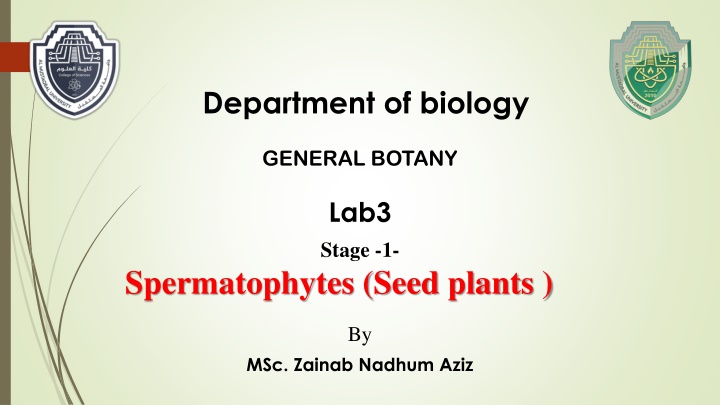
Understanding Spermatophytes: Seed Plants for Botany Enthusiasts
Explore the world of seed plants, particularly Spermatophytes, in this informative guide covering their classification, characteristics, and importance in the plant kingdom. Learn about Gymnosperms and Angiosperms, with detailed insights into Non-Vascular Plants as well. Dive into the diversity and significance of these botanical wonders in the natural world.
Download Presentation

Please find below an Image/Link to download the presentation.
The content on the website is provided AS IS for your information and personal use only. It may not be sold, licensed, or shared on other websites without obtaining consent from the author. If you encounter any issues during the download, it is possible that the publisher has removed the file from their server.
You are allowed to download the files provided on this website for personal or commercial use, subject to the condition that they are used lawfully. All files are the property of their respective owners.
The content on the website is provided AS IS for your information and personal use only. It may not be sold, licensed, or shared on other websites without obtaining consent from the author.
E N D
Presentation Transcript
Department of biology GENERAL BOTANY Lab3 Stage -1- Spermatophytes (Seed plants ) By MSc. Zainab Nadhum Aziz
Spermatophytes (Seed plants ) Seed plants, often known as flowering plants, are the most dominant plants on Earth. This is primarily due to their seed formation following fertilization and other advanced characteristics. Gymnosperms are among the archaea, so gymnosperms are the simplest of seed plants. They are a link between ferns and angiosperms. They are older and more primitive than angiosperms. They are of great economic importance because they are a major source of timber. Seed plants, often known as flowering plants, are the most dominant plants on Earth. This is primarily due to their seed formation following fertilization and other advanced characteristics. Gymnosperms are among the archaea, so gymnosperms are the simplest of seed plants. They are a link between ferns and angiosperms. They are older and more primitive than angiosperms. They are of great economic importance because they are a major source of timber.
The Five Kingdoms 1. Kingdom Monera 2. Kingdom Protista 3. Kingdom Fungi 4. Kingdom Plantae 5. Kingdom Animalia
Classification of Kingdom Plantae Vascular Plant Non-Vascular Plant Seedless Seedling Angiosperms Gymnosperms
Seedling Angiosperms Gymnosperms
Non-Vascular Plant These plants lack composed vascular tissue, which is one of their characteristics. The root, stem, and leaves, as well as from and phloem , and reproduces by spores.
Classification of non-vascular plants a. Thallophyta example (algae and fungi). b. Bryophyta example (Mosses).
Seedling They are plants that reproduce by seed It is divided into: 1.Gymnosperms: Its seeds are exposed, such as pine. 2. Angiosperms: Flowering plants that contain seeds inside the fruit divided into dicotyledonous and monocotyledonous plants such as apricot.
Gymnosperms General characteristics : 1. It includes perennial woody plants, either trees or shrubs, most of which are evergreen. A few are deciduous and adapted to life in the desert environment. 2. They have true roots and are large taproots containing diagonal vascular bundles. The wood is on the inside and the bark is on the outside.
Gymnosperms 3.They have stems and leaves (scaly and vegetative). 4. The vascular bundles in the stem are arranged in a ring, with the wood on the inside and the bark on the outside. 5. The sexual reproductive organs are grouped in the form of cones, which are either male or female cones. 6. Pollen grains are transported by the wind to the female gametophyte (inside the female cone). 7. One seed contains two or more cotyledons.
Their Relationship with Ferns Gymnosperms resemble ferns in several characteristics, the most important of which are: 1-The vegetative body of the plant represents the sporophyte phase, which is characterized by a root, stem, and leaves. 2- A few gymnosperms have compound leaves with veins, as in ferns. 3- The absence of vessels in the xylem. 4- The gametophyte is significantly reduced, but it differs from ferns in that it relies entirely on the sporophyte. 6- Gymnosperms are mixed-spore, as is the case with some ferns. 7- Some gymnosperms produce multi-flagellar sperm, as in the Cycas plant.
Gymnosperms are characterized by more advanced traits than ferns 1. The presence of a long, perennial taproot. 2. Gymnosperms are more adapted to desert environments than ferns. 3. The presence of secondary growth in the root and stem. 4. The absence of neck canal cells in the archaea, and sometimes the absence of a ventral canal cell. 5. Pollination is mostly by wind, not water. 6. Seed formation
Relationship with angiosperms Gymnosperms resemble angiosperms in several characteristics, the most important of which are the following: 1- The plants are trees or shrubs. 2- The plant body represents the sporophyte stage and is distinguished into a root, stem, and leaves. 3- The leaves are either simple or compound. 4- The formation of cones is similar to flowering. 5- The anatomical structure of the stem and root is similar to that of dicotyledonous plants, except for the absence of vessels.






















